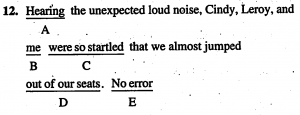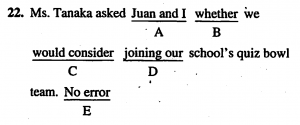Pronouns come in different flavors?
Yep, they actually do. Technically it’s called pronoun case – pronouns are different when they are used as a subject or an object – but I don’t teach it this way. Here are the rules, if you are interested. I’ve just found that my students fall into a stupor when I start talking about grammatical terms – so instead I just teach them to recognize pronoun cases as different flavors.
Chocolate or vanilla?
Which form of the pronoun do you use? It depends on the sentence.
- I or me
- she, he or her, him
- we or us
- they or them
- which or who
- these or those
The trick is to get rid of the other pronouns and just listen to the one in question. The majority of the time, my students can “hear” which form is correct.
Here’s an example from page 471 in the Blue Book.
Ask these questions:
- Are there any underlined pronouns?
Yes. Choice B has “me.” - What else could it be?
It will either be “me” or “I.” - Which sounds right?
Isolate the pronoun and test each flavor.
“I was so startled”
“Me was so startled”
“I” works, so therefore it should say “..Cindy, Leroy, and I were so startled..”
Here’s an example from page 957 in the Blue Book.
Ask these questions:
- Are there any underlined pronouns?
Yes. Choice B has “I.” - What else could it be?
It will either be “I” or “me.” - Which sounds right?
Isolate the pronoun and test out each flavor.
“Mrs. Tanaka asked I..”
“Mrs. Tanaka asked me…”
“Mrs. Tanaka asked me” works so the sentence should read, “Mrs. Tanaka asked Juan and me…”
Next steps
You’ve already learned about pronoun-noun agreement and ambiguous pronouns. Now, try your hand at answering these pronoun questions.
Image credit: Ollie Crayfoord at Flickr


